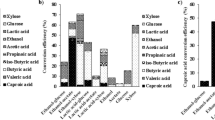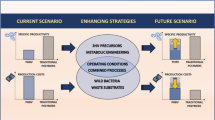Abstract
We employed systematic mixture analysis to determine optimal levels of acetate, propionate, and butyrate for cell growth and polyhydroxyalkanoate (PHA) production by Ralstonia eutropha H16. Butyrate was the preferred acid for robust cell growth and high PHA production. The 3-hydroxyvalerate content in the resulting PHA depended on the proportion of propionate initially present in the growth medium. The proportion of acetate dramatically affected the final pH of the growth medium. A model was constructed using our data that predicts the effects of these acids, individually and in combination, on cell dry weight (CDW), PHA content (%CDW), PHA production, 3HV in the polymer, and final culture pH. Cell growth and PHA production improved approximately 1.5-fold over initial conditions when the proportion of butyrate was increased. Optimization of the phosphate buffer content in medium containing higher amounts of butyrate improved cell growth and PHA production more than 4-fold. The validated organic acid mixture analysis model can be used to optimize R. eutropha culture conditions, in order to meet targets for PHA production and/or polymer HV content. By modifying the growth medium made from treated industrial waste, such as palm oil mill effluent, more PHA can be produced.






Similar content being viewed by others

References
Ahmad AL, Ismail S, Bhatia S (2003) Water recycling from palm oil mill effluent (POME) using membrane technology. Desalination 157:87–95
Ahn WS, Park SJ, Lee SY (2000) Production of poly(3-hydroxybutyrate) by fed-batch culture of recombinant Escherichia coli with a highly concentrated whey solution. Appl Environ Microbiol 66:3624–3627
Anderson AJ, Dawes EA (1990) Occurrence, metabolism, metabolic role, and industrial uses of bacterial polyhydroxyalkanoates. Microbiol Rev 54:450–472
Basiron Y (2007) Palm oil production through sustainable plantations. Eur J Lipid Sci Tech 109:289–295
Bhubalan K, Lee WH, Loo CY, Yamamoto T, Tsuge T, Doi Y, Sudesh K (2008) Controlled biosynthesis and characterization of poly(3-hydroxybutyrate-co-3-hydroxyvalerate-co-3-hydroxyhexanoate) from mixtures of palm kernel oil and 3HV-precursors. Polym Degrad Stabil 93:17–23
Brandl H, Gross RA, Lenz RW, Fuller RC (1988) Pseudomonas oleovorans as a source of poly(beta-hydroxyalkanoates) for potential applications as biodegradable polyesters. Appl Environ Microbiol 54:1977–1982
Chakraborty P, Gibbons W, Muthukumarappan K (2009) Conversion of volatile fatty acids into polyhydroxyalkanoate by Ralstonia eutropha. J Appl Microbiol 106:1996–2005
Chen GQ, Wu Q (2005) The application of polyhydroxyalkanoates as tissue engineering materials. Biomaterials 26:6565–6578
Choi J, Lee SY (2000) Economic considerations in the production of poly(3-hydroxybutyrate-co-3-hydroxyvalerate) by bacterial fermentation. Appl Microbiol Biotechnol 53:646–649
Chua ASM, Takabatake H, Satoh H, Mino T (2003) Production of polyhydroxyalkanoates (PHA) by activated sludge treating municipal wastewater: effect of pH, sludge retention time (SRT), and acetate concentration in influent. Water Res 37:3602–3611
Cornibert J, Marchessault RH (1972) Physical properties of poly-β-hydroxybutyrate. IV. Conformational analysis and crystalline structure. J Mol Biol 71:735–756
Doi Y, Tamaki A, Kunioka M, Soga K (1988) Production of copolyesters of 3-hydroxybutyrate and 3-hydroxyvalerate by Alcaligenes eutrophus from butyric and pentanoic acids. Appl Microbiol Biotechnol 28:330–334
Doi Y, Kitamura S, Abe H (1995) Microbial synthesis and characterization of poly(3-hydroxybutyrate-co-3-hydroxyhexanoate). Macromolecules 28:4822–4828
Frazzetto G (2003) White biotechnology—the application of biotechnology to industrial production holds many promises for sustainable development, but many products still have to pass the test of economic viability. EMBO Rep 4:835–837
Füchtenbusch B, Wullbrandt D, Steinbüchel A (2000) Production of polyhydroxyalkanoic acids by Ralstonia eutropha and Pseudomonas oleovorans from an oil remaining from biotechnological rhamnose production. Appl Microbiol Biotechnol 53:167–172
Hassan MA, Shirai Y, Kusubayashi N, Karim MIA, Nakanishi K, Hashimoto K (1996) Effect of organic acid profiles during anaerobic treatment of palm oil mill effluent on the production of polyhydroxyalkanoates by Rhodobacter sphaeroides. J Ferment Bioeng 82:151–156
Hassan MA, Nawata O, Shirai Y, Rahman NAA, Yee PL, Bin Ariff A, Ismail M, Karim A (2002) A proposal for zero emission from palm oil industry incorporating the production of polyhydroxyalkanoates from palm oil mill effluent. J Chem Eng Jpn 35:9–14
Jendrossek D, Handrick R (2002) Microbial degradation of polyhydroxyalkanoates. Annu Rev Microbiol 56:403–432
Khanna S, Srivastava AK (2005) A simple structured mathematical model for biopolymer (PHB) production. Biotechnol Prog 21:830–838
Kunioka M, Doi Y (1990) Thermal degradation of microbial copolyesters: poly(3-hydroxybutyrate-co-3-hydroxyvalerate) and poly(3-hydroxybutyrate-co-4-hydroxybutyrate). Macromolecules 23:1933–1936
Liu HY, Hall PV, Darby JL, Coats ER, Green PG, Thompson DE, Loge FJ (2008) Production of polyhydroxyalkanoate during treatment of tomato cannery wastewater. Water Environ Res 80:367–372
Loo CY, Lee WH, Tsuge T, Doi Y, Sudesh K (2005) Biosynthesis and characterization of poly(3-hydroxybutyrate-co-3-hydroxyhexanoate) from palm oil products in a Wautersia eutropha mutant. Biotechnol Lett 27:1405–1410
Madison LL, Huisman GW (1999) Metabolic engineering of poly(3-hydroxyalkanoates): from DNA to plastic. Microbiol Mol Biol Rev 63:21–53
Marangoni C, Furigo A, de Aragdo GMF (2002) Production of poly(3-hydroxybutyrate-co-3-hydroxyvalerate) by Ralstonia eutropha in whey and inverted sugar with propionic acid feeding. Process Biochem 38:137–141
Mergaert J, Anderson C, Wouters A, Swings J, Kersters K (1992) Biodegradation of polyhydroxyalkanoates. FEMS Microbiol Rev 9:317–321
Misra SK, Valappil SP, Roy I, Boccaccini AR (2006) Polyhydroxyalkanoate (PHA)/inorganic phase composites for tissue engineering applications. Biomacromolecules 7:2249–2258
Nikel PI, Pettinari MJ, Mendez BS, Galvagno MA (2005) Statistical optimization of a culture medium for biomass and poly(3-hydroxybutyrate) production by a recombinant Escherichia coli strain using agroindustrial byproducts. Int Microbiol 8:243–250
Nikel PI, de Almeida A, Melillo EC, Galvagno MA, Pettinari MJ (2006) New recombinant Escherichia coli strain tailored for the production of poly(3-hydroxybutyrate) from agroindustrial by-products. Appl Environ Microbiol 72:3949–3954
Nowruzi K, Elkamel A, Scharer JM, Cossar D, Moo-Young M (2008) Development of a minimal defined medium for recombinant human interleukin-3 production by Streptomyces lividans 66. Biotechnol Bioeng 99:214–222
Scandola M, Ceccorulli G, Pizzoli M, Gazzano M (1992) Study of the crystal phase and crystallization rate of bacterial poly(3-hydroxybutyrate-co-3-hydroxyvalerate). Macromolecules 25:1405–1410
Sim SJ, Snell KD, Hogan SA, Stubbe J, Rha C, Sinskey AJ (1997) PHA synthase activity controls the molecular weight and polydispersity of polyhydroxybutyrate in vivo. Nat Biotechnol 15:63–67
Steinbüchel A, Füchtenbusch B (1998) Bacterial and other biological systems for polyester production. Trends Biotechnol 16:419–427
Sudesh K, Abe H, Doi Y (2000) Synthesis, structure and properties of polyhydroxyalkanoates: biological polyesters. Prog Polym Sci 25:1503–1555
Tan IKP, Kumar KS, Theanmalar M, Gan SN, Gordon B (1997) Saponified palm kernel oil and its major free fatty acids as carbon substrates for the production of polyhydroxyalkanoates in Pseudomonas putida PGA1. Appl Microbiol Biotechnol 47:207–211
Wang J, Yu J (2001) Kinetic analysis on formation of poly(3-hydroxybutyrate) from acetic acid by Ralstonia eutropha under chemically defined conditions. J Ind Microbiol Biot 26:121–126
Wilde E (1962) Untersuchungen über wachstum und speicherstoffsynthese von hydrogenomonas. Arch Mikrobiol 43:109–137
Williams SF, Martin DP, Horowitz DM, Peoples OP (1999) PHA applications: addressing the price performance issue: I. Tissue engineering. Int J Biol Macromol 25:111–121
Wu Q, Wang Y, Chen GQ (2009a) Medical application of microbial biopolyesters polyhydroxyalkanoates. Artif Cell Blood Sub Biot 37:1–12
Wu TY, Mohammad AW, Jahim JM, Anuar N (2009b) A holistic approach to managing palm oil mill effluent (POME): Biotechnological advances in the sustainable reuse of POME. Biotechnol Adv 27:40–52
Yee PL, Hassan MA, Shirai Y, Wakisaka M, Karim MIA (2003) Continuous production of organic acids from palm oil mill effluent with sludge recycle by the freezing-thawing method. J Chem Eng Jpn 36:707–710
York GM, Lupberger J, Tian J, Lawrence AG, Stubbe J, Sinskey AJ (2003) Ralstonia eutropha H16 encodes two and possibly three intracellular Poly[D-(−)-3-hydroxybutyrate] depolymerase genes. J Bacteriol 185:3788–3794
Young AL (2003) Biotechnology for food, energy, and industrial products—new opportunities for bio-based products. Environ Sci Pollut R 10:273–276
Zaldivar J, Nielsen J, Olsson L (2001) Fuel ethanol production from lignocellulose: a challenge for metabolic engineering and process integration. Appl Microbiol Biotechnol 56:17–34
Acknowledgements
The authors thank Mr. John Quimby and Ms. Karen Pepper for their contributions to this manuscript. This work was supported by a grant from the government of Malaysia and the Malaysian Office of Science, Technology and Innovation (MOSTI). The result of this grant, the Malaysia-MIT Biotechnology Partnership Program (MMBPP), is a collaboration between MIT, SIRIM Berhad, Universiti Putra Malaysia, and Universiti Sains Malaysia. The authors would like to thank the members of this program for their collegial collaborations.
Author information
Authors and Affiliations
Corresponding author
Electronic supplementary materials
Below is the link to the electronic supplementary material.
Online Resource 1
(DOC 44 kb)
Online Resource 2
(DOC 66 kb)
Online Resource 3
(DOC 29 kb)
Online Resource 3
(DOC 62 kb)
Rights and permissions
About this article
Cite this article
Yang, YH., Brigham, C.J., Budde, C.F. et al. Optimization of growth media components for polyhydroxyalkanoate (PHA) production from organic acids by Ralstonia eutropha . Appl Microbiol Biotechnol 87, 2037–2045 (2010). https://doi.org/10.1007/s00253-010-2699-8
Received:
Revised:
Accepted:
Published:
Issue Date:
DOI: https://doi.org/10.1007/s00253-010-2699-8



